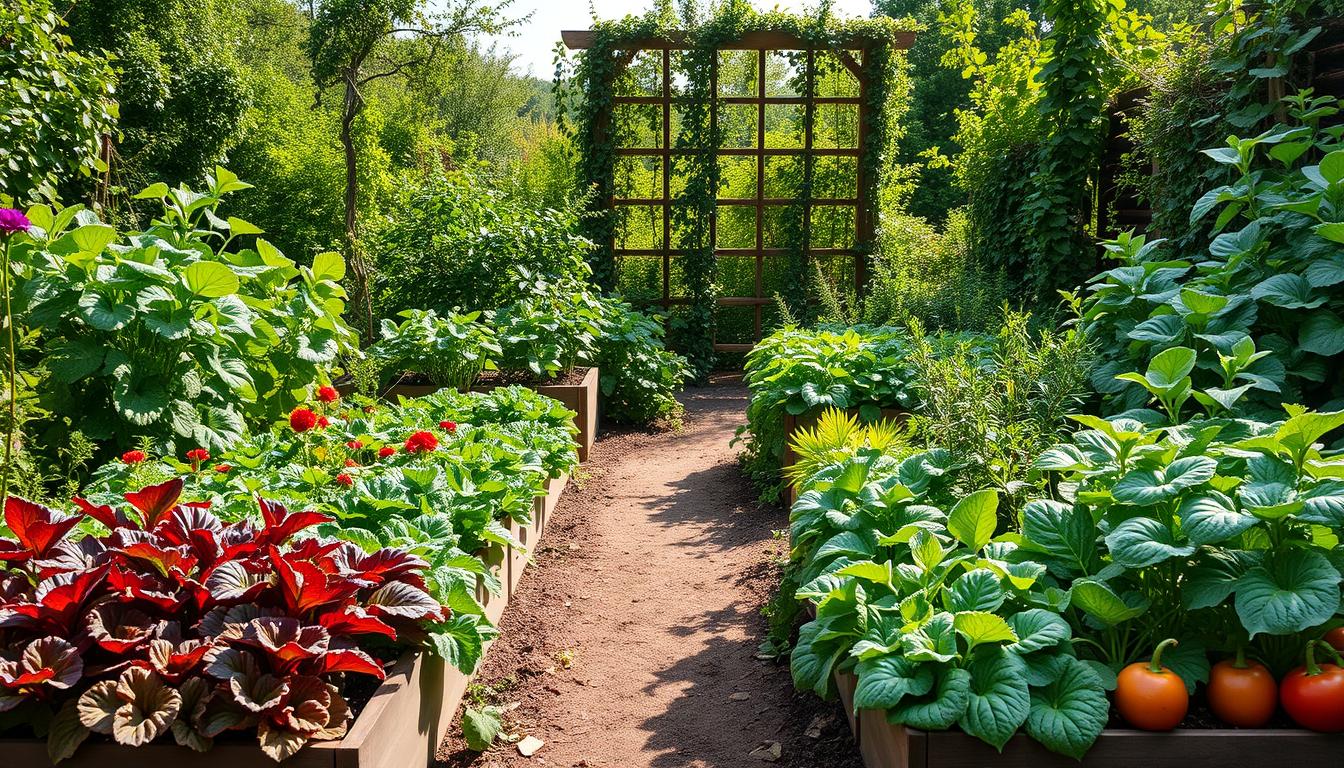Growing fresh produce at home brings immense satisfaction and a sense of accomplishment. With a little planning, you can transform any area into a thriving space for your favorite plants. A well-thought-out setup not only maximizes yield but also makes maintenance easier and more enjoyable.
From spring asparagus to summer tomatoes, a carefully designed arrangement ensures a steady harvest throughout the year. Key factors like sunlight exposure, water access, and plant selection play a crucial role in success. Real-world examples from experienced growers show how small adjustments can lead to big results.
Whether you’re working with a small balcony or a spacious backyard, optimizing your setup can make all the difference. Start with a clear plan, and soon you’ll be enjoying the fruits (and vegetables) of your labor.
Key Takeaways
- Growing fresh produce at home is rewarding and fulfilling.
- Proper planning maximizes yield and simplifies maintenance.
- Seasonal plants ensure a year-round harvest.
- Sunlight, water, and plant selection are critical factors.
- Real-world examples provide practical insights.
1. Introduction to the Best Garden Layout for Vegetables
Designing a productive growing space starts with thoughtful planning. A well-thought-out layout not only enhances plant health but also reduces pest issues. By spacing plants correctly and using natural barriers, you can create a thriving environment for your crops.
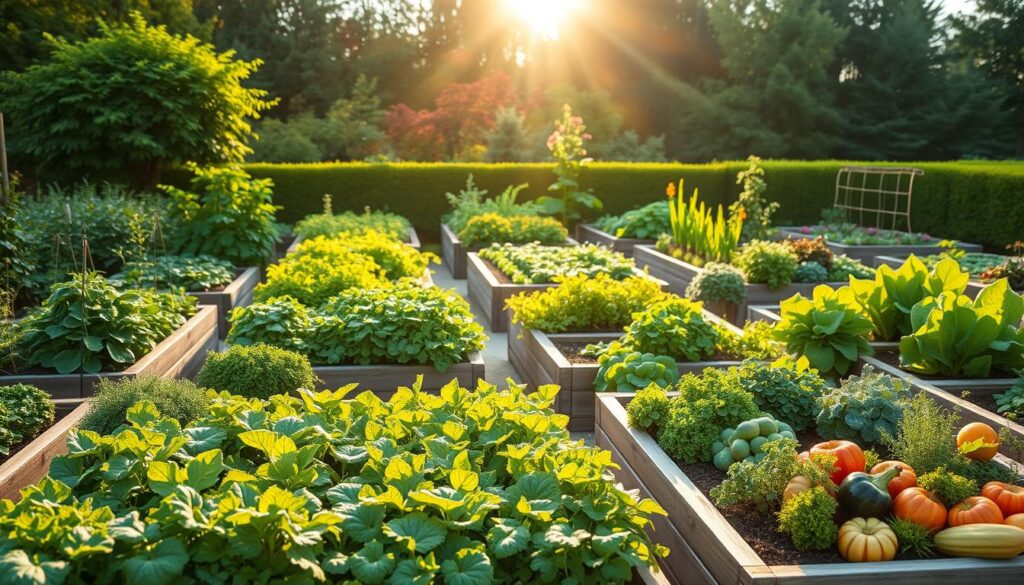
Balancing aesthetics with functionality is key. Decorative pots, trellises, and raised beds can add visual appeal while maximizing your growing space. These elements also make maintenance easier and more enjoyable.
Starting small is a smart strategy. Beginners often find success with 3-4 ft beds, which are easier to manage and maintain. This approach allows you to focus on quality rather than quantity, ensuring healthier plants and better yields.
Keeping a journal of your successes and failures is a valuable habit. Documenting what works and what doesn’t helps you refine your layout over time. This continuous improvement process ensures long-term success.
Companion planting is another effective technique. Pairing compatible plants can naturally deter pests and improve soil health. For example, planting marigolds near tomatoes can reduce harmful insects, creating a healthier vegetable garden.
2. Choosing the Perfect Site for Your Vegetable Garden
Selecting the right location is the foundation of a thriving growing space. The ideal spot ensures your plants receive the resources they need to flourish. Focus on three key factors: sunlight, water access, and soil quality.

Sunlight Requirements
Most vegetables need 6-8 hours of direct sun daily. South, east, and west-facing areas typically receive more sunlight than north-facing spots. Use sun mapping techniques to track light patterns throughout the day.
For example, a 4×8 ft raised bed placed in a sunny corner can maximize light exposure. Avoid shaded areas near large trees or buildings, as they can block essential sunlight.
Proximity to Water Source
Having a water source nearby is crucial for consistent irrigation. Position rain barrels or hoses within easy reach to avoid heavy carrying. This ensures your plants stay hydrated without extra effort.
In-ground setups often require more water than container gardens. Plan accordingly to meet the specific needs of your chosen setup.
Avoiding Competition with Existing Vegetation
Existing trees and plants can compete for nutrients and water. For instance, walnut trees produce soil toxins harmful to vegetables. Test soil pH near trees before planting to ensure compatibility.
Clear the area of weeds and invasive plants to give your crops the best chance to thrive. Proper spacing and natural barriers can also reduce competition.
| Feature | In-Ground Garden | Container Garden |
|---|---|---|
| Water Needs | High | Moderate |
| Sunlight Access | Dependent on location | Easily movable |
| Soil Quality | Requires testing | Customizable |
3. Deciding What to Grow in Your Vegetable Garden
Choosing the right plants for your space can make all the difference in your harvest. Start by listing your favorite vegetables and prioritize those that are expensive to buy at the store. This approach ensures you get the most value from your efforts.
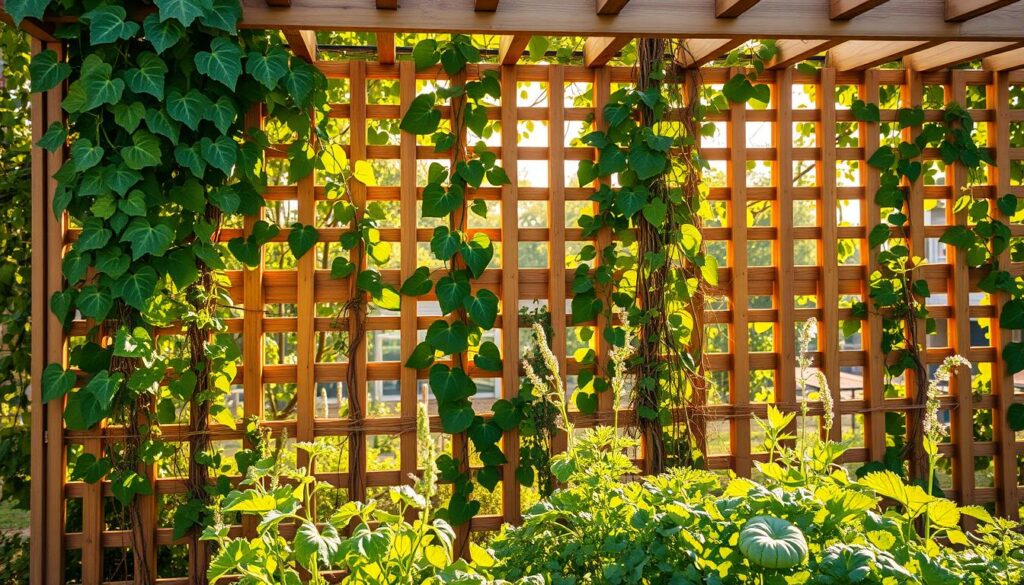
3.1 Listing Your Favorite Vegetables
Begin with a “must-grow” list. Include staples like tomatoes, peppers, and cucumbers. If you love fresh salads, add lettuce and spinach. Don’t forget perennials like asparagus, which require a permanent spot but reward you with years of harvests.
For small spaces, consider cherry tomatoes. They thrive in hanging baskets and produce abundant fruit. Pole beans are another excellent choice, offering vertical efficiency compared to bush varieties.
3.2 Incorporating Space-Saving Trellises
Vertical gardening is a game-changer for maximizing space. A single trellis can save up to 16 square feet of horizontal area. Vining crops like cucumbers and peas are perfect for this method.
Strawberry towers are another innovative solution for small spaces. They allow you to grow multiple plants in a compact area. Using containers and trellises not only saves space but also makes maintenance easier.
By carefully selecting your plants and incorporating vertical techniques, you can create a productive and visually appealing setup. Start small, experiment, and enjoy the process of growing your own food.
4. Planning Your Vegetable Garden Layout on Paper
Mapping out your growing space on paper ensures precision and efficiency. A detailed plan helps you visualize the setup, avoid mistakes, and make the most of your available area. Whether you’re working with a small plot or a larger space, starting with a sketch is a smart move.
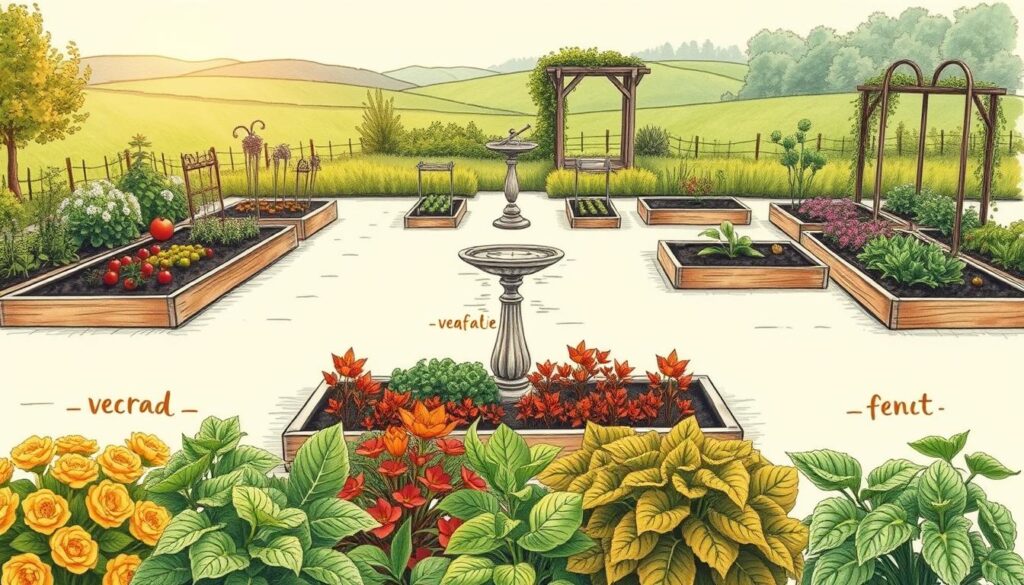
Using Graph Paper for Precision
Graph paper is a handy tool for creating accurate measurements. Use a scale of one foot per box to map out your space. This method allows you to plan bed widths, pathways, and plant placements with ease.
For example, a 3-4 ft wide raised bed fits perfectly on the grid. Leave 2.5 ft between beds for wheelbarrow access. This approach ensures your setup is both functional and efficient.
Measuring Your Garden Space
Accurate measurements are essential for a successful garden layout. Use a tape measure to determine the exact dimensions of your area. Mark these on your graph paper to create a realistic plan.
Grid-based planning also supports succession planting. By rotating crops and using cut-out plant markers, you can adapt your layout as the season progresses. This flexibility maximizes yield and keeps your space productive.
For digital enthusiasts, apps like Garden Planner offer advanced tools for designing your setup. These programs help calculate yield per square foot and optimize spacing for better results.
A case study showed a 20% yield increase with proper spacing and planning. Taking the time to map out your space pays off in healthier plants and a more abundant harvest.
5. Arranging Plants in Your Vegetable Garden
Arranging your plants thoughtfully can significantly boost their health and productivity. Proper placement ensures each plant gets the resources it needs, from sunlight to nutrients. A well-organized setup also makes maintenance easier and more enjoyable.
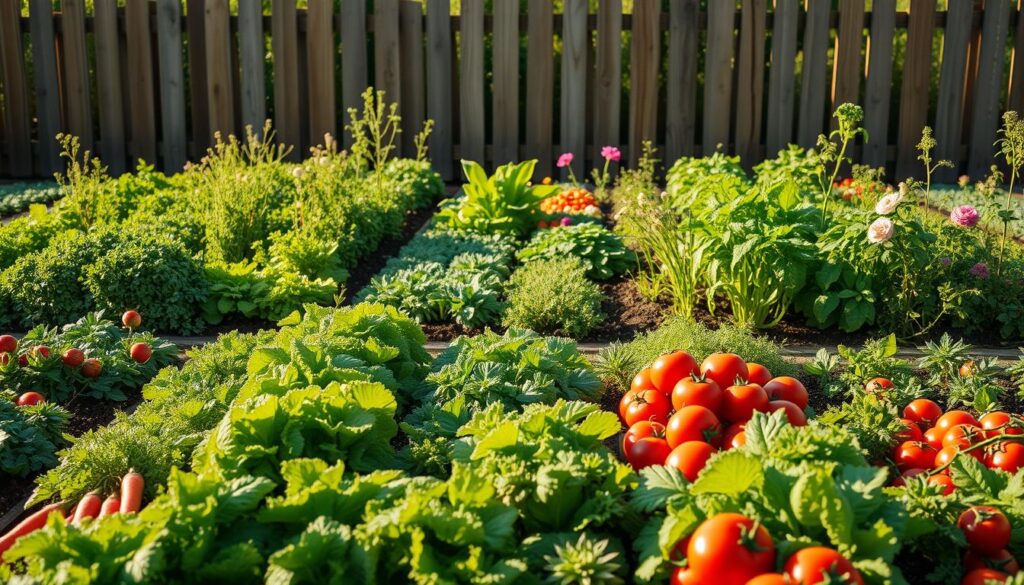
5.1 Spacing Between Plants
Correct spacing is crucial for healthy growth. Overcrowding can lead to competition for resources and increased pest issues. For example, tomatoes need about 24 inches of space, while lettuce thrives with just 8 inches.
Consider allelopathy, where certain plants inhibit the growth of others. Sunflowers, for instance, release chemicals that can stunt nearby crops. Plan your arrangement to avoid such conflicts.
Using sacrificial plants like nasturtiums can divert pests away from your main crops. This natural pest control method keeps your setup healthier without chemicals.
5.2 Plant Height Considerations
Taller plants should be placed on the north side to prevent shading shorter ones. This ensures all plants receive adequate sun throughout the day. For example, corn or trellised beans work well in this position.
Taller crops can also create microclimates, protecting smaller plants from wind or intense heat. This strategic placement maximizes the benefits of your growing space.
Intercropping is another effective technique. Planting radishes before squash, for instance, allows you to harvest two crops in one season. This method optimizes space and increases yield.
6. Incorporating Raised Beds into Your Garden Layout
Raised beds offer a versatile solution for growing healthy plants in limited spaces. They provide better control over soil quality, improve drainage, and make maintenance easier. Whether you’re a beginner or an experienced grower, raised beds can transform your outdoor area into a productive and organized space.
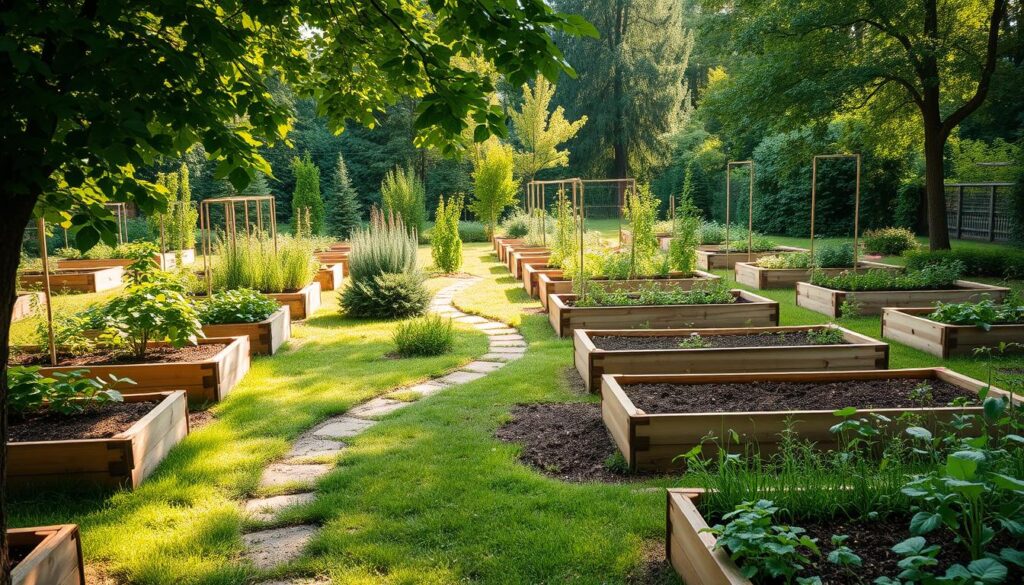
Benefits of Raised Beds
One of the main advantages of raised beds is their ability to warm up faster in spring. This allows for earlier planting and extends the growing season. The elevated design also reduces soil compaction, promoting healthier root systems.
Another benefit is improved drainage. Raised beds prevent waterlogging, which is especially useful in areas with heavy rainfall. They also make it easier to manage soil amendments, ensuring your plants get the nutrients they need.
Building and Maintaining Raised Beds
When building raised beds, choose materials like untreated cedar or recycled plastic lumber. These options are durable and safe for growing edible plants. A depth of 10-12 inches is ideal for most root crops.
For a self-fertilizing setup, consider hugelkultur layering. This technique uses logs and organic matter to create a nutrient-rich base. It’s an eco-friendly way to boost soil fertility over time.
Regular maintenance is key to keeping your garden beds productive. Test the soil annually and add compost as needed. Use liners like hardware cloth or landscape fabric to prevent weeds and pests.
| Feature | DIY Raised Beds | Pre-Made Kits |
|---|---|---|
| Cost | Lower | Higher |
| Customization | High | Limited |
| Installation Time | Longer | Shorter |
7. Companion Planting for a Thriving Vegetable Garden
Pairing plants strategically can enhance growth and deter pests naturally. This method, known as companion planting, creates a symbiotic relationship between different species. It maximizes space, improves soil health, and reduces the need for chemical interventions.

Benefits of Companion Planting
One of the main advantages of companion planting is pest control. Certain plants repel harmful insects, protecting their neighbors. For example, basil planted near tomatoes deters tomato hornworms, while marigolds keep nematodes away from cucumbers.
Another benefit is improved pollination. Flowers like nasturtiums attract pollinators, ensuring a better harvest. Additionally, some plants enrich the soil by fixing nitrogen, benefiting nearby crops.
Examples of Companion Plants
Here are some effective plant pairings to try:
- Onions and carrots: Onions repel carrot flies, while carrots deter onion pests.
- Corn, beans, and squash: Known as the “Three Sisters,” these plants support each other’s growth.
- Nasturtiums and cucumbers: Nasturtiums act as a trap crop, attracting aphids away from cucumbers.
Be cautious with allelopathic pairs. For instance, fennel can stunt the growth of tomatoes. Always research plant compatibility before pairing.
| Plant | Companion | Benefit |
|---|---|---|
| Tomatoes | Basil | Repels hornworms |
| Cucumbers | Marigolds | Deters nematodes |
| Carrots | Onions | Mutual pest protection |
8. Designing Your Vegetable Garden for Small Spaces
Small spaces can still yield abundant harvests with the right techniques. Whether you have a tiny balcony or a narrow patio, creative solutions can help you maximize every inch. From vertical structures to compact plant varieties, there are plenty of ways to grow fresh produce in limited areas.
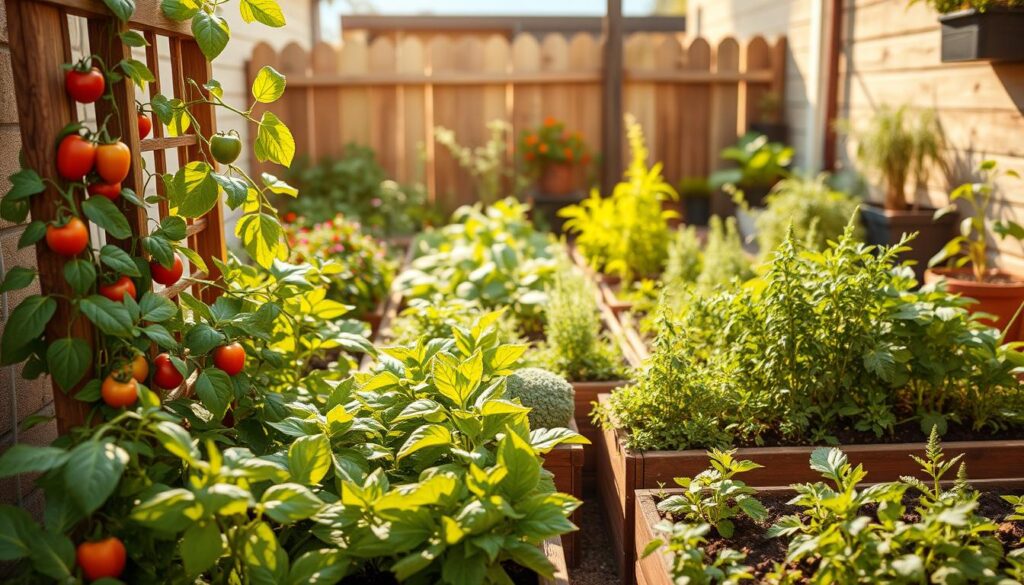
Vertical Gardening Techniques
Vertical gardening is a game-changer for small space setups. Trellises, towers, and wall planters allow you to grow upwards, saving valuable ground area. For example, trellised cucumbers can yield twice as much as their ground-grown counterparts.
Popular systems like GreenStalk and EarthBox offer modular designs for stacking plants. These are ideal for growing herbs, strawberries, or leafy greens. Balcony rail planters are another excellent option, making use of vertical surfaces for added productivity.
Using Containers and Hanging Baskets
Containers are versatile and perfect for small areas. A 5-gallon bucket works well for peppers, while compact varieties like ‘Patio Baby’ eggplants thrive in smaller pots. Hanging baskets are great for cherry tomatoes or trailing plants like nasturtiums.
Reflective surfaces can boost light in shaded spots. Place mirrors or white boards strategically to redirect sunlight to your plants. This simple trick can make a big difference in areas with limited shade.
Here’s a quick comparison of vertical gardening systems:
| System | Best For | Space Efficiency |
|---|---|---|
| GreenStalk | Herbs, strawberries | High |
| EarthBox | Vegetables, flowers | Moderate |
For more tips on starting your own setup, check out this beginner’s guide to gardening. With a little creativity, even the smallest spaces can become productive and rewarding.
9. Rotating Crops to Maintain Soil Health
Maintaining healthy soil is essential for a productive growing space. One of the most effective ways to achieve this is through crop rotation. This practice involves changing the types of plants grown in specific areas each season. It prevents nutrient depletion and reduces the risk of diseases.
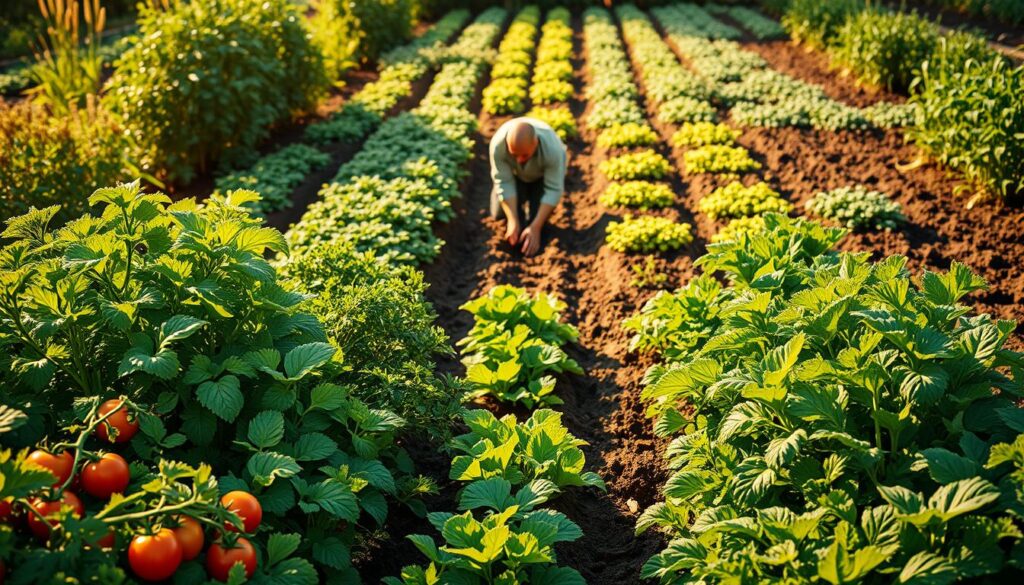
Importance of Crop Rotation
Rotating crops helps balance nutrients in the soil. Different plants use and replenish nutrients in unique ways. For example, legumes like beans and peas fix nitrogen, which benefits heavy feeders like corn or tomatoes. A 4-year rotation cycle is ideal for preventing soil-borne diseases.
Cover cropping between seasons is another effective strategy. Plants like clover or rye add organic matter and improve soil structure. This practice also prevents erosion and suppresses weeds.
Planning Crop Rotation in Your Garden
Start by creating a color-coded rotation map. This visual tool helps you track which plants grow where each year. Group plants by their nutrient needs and growth habits. For instance, root crops like carrots and potatoes should follow leafy greens.
Testing your soil before and after rotation is crucial. Kits are available to measure pH and nutrient levels. Adjust your planting plan based on the results to ensure optimal soil health.
| Plant Type | Nutrient Depletion | Rotation Example |
|---|---|---|
| Legumes | Adds nitrogen | Follow with corn |
| Leafy Greens | High nitrogen use | Follow with root crops |
| Root Crops | Low nutrient use | Follow with legumes |
By planning your crop rotation carefully, you can maintain fertile soil and enjoy healthier plants year after year.
10. Learning from Your Garden’s Successes and Failures
Reflecting on your growing journey helps you improve and adapt over time. Whether you’re a beginner or an experienced grower, documenting your progress is key to long-term success. By keeping track of what works and what doesn’t, you can make informed adjustments for future seasons.

Keeping a Garden Journal
A garden journal is a powerful tool for tracking your progress. Start by recording key details like weather patterns, first and last frost dates, and pest emergence. This data helps you identify trends and plan better for the next season.
Include sections for yields, issues, and solutions. For example, note which plants thrived and which struggled. Photos can also be a helpful addition, providing a visual record of your setup over the years.
Common first-year mistakes include overcrowding and improper spacing. Document these lessons to avoid repeating them. Over time, your journal will become a valuable resource for continuous improvement.
Adjusting Your Layout for Future Seasons
Based on your journal entries, make adjustments to your setup. For instance, if certain plants didn’t perform well, consider relocating them or trying a different variety. Rotate crops to maintain soil health and prevent pest buildup.
Create a “lessons learned” action plan. This might include adding more trellises for vertical growth or expanding your space by 10% yearly. Gradual changes ensure steady progress without overwhelming you.
Here are some tips for refining your approach:
- Test soil annually and amend as needed.
- Experiment with companion planting for natural pest control.
- Use reflective surfaces to maximize sunlight in shaded areas.
By learning from your experiences, you can create a more efficient and productive setup. Every season brings new opportunities to grow and improve.
11. Conclusion: Creating Your Ideal Vegetable Garden Layout
Creating a thriving garden for fresh produce is both rewarding and achievable with the right approach. Focus on key principles like sunlight, spacing, soil health, succession planting, and sustainability. These elements ensure a bountiful harvest and a healthy growing environment.
Start small and implement changes gradually. Perfection isn’t the goal—progress is. Local resources like Plant Perfect nursery can provide guidance and materials tailored to your needs.
Imagine enjoying seasonal meals straight from your outdoor space. From crisp salads in summer to hearty soups in fall, the possibilities are endless. Begin today by sketching your vegetable garden layout and turning your vision into reality.

